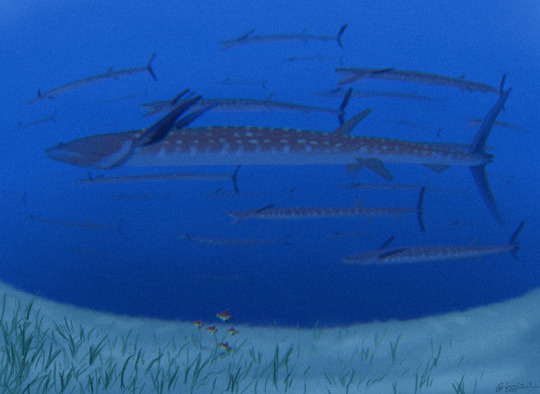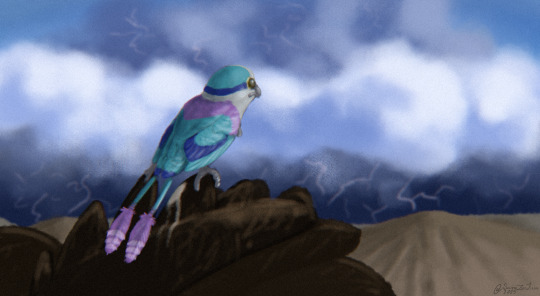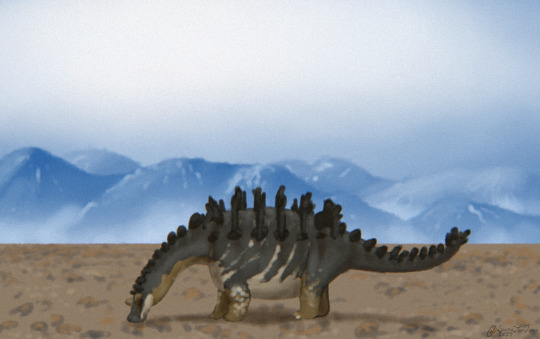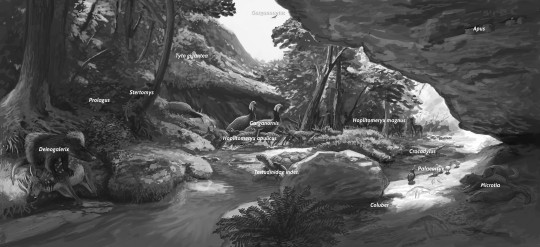Don't wanna be here? Send us removal request.
Text
Lemuria Flocking #1 (28/06/2025)
Joschua is in Poland atm so for this week's #Paleostream Gnath and I hosted a #LemuriaChallenge themed flocking where we sketched Megalognathus, The Harbinger Bird (Unusqui scitpericuli), Cervidactylus elegans, and The Last Stegosaur (Deimaximerror cacasexano)




122 notes
·
View notes
Text




Super cool flocking this week with four very recently described animals! 7-25-25
Palaeocampa, Nektognathus, Wudingloong, Mirasaura
50 notes
·
View notes
Text




Flocking Together
Palaeocampa/Nektognathus
Wudingloong/Mirasaura
24 notes
·
View notes
Text
#Paleostream 26/07/2025
here's this week's #Paleostream flocking drawings!!!
this week we drew Palaeocampa, Nektognathus, Wudingloong, and Mirasaura




152 notes
·
View notes
Text




Flocking Together
Simbakubwa/Postschizotherium
Brygmophyseter/Venetoraptor
24 notes
·
View notes
Text




Forgot to post the Flocking sketches! #paleostream Simbakubwa, Postschizotherium, Brygmophyseter and Venetoraptor.
357 notes
·
View notes
Text

Adding the Ocher sub-assemblage zone from the Middle Permian of Russia! Estemmenosuchus, Estemmenosuchus everywhere!
We are approaching the maximum of images you can post here so I thought it was time I make a little showcase of all the formation pieces we covered so far on the streams.





























For people who don't know: for several months now I draw one formation or fossil locality every Saturday. The next place we visit is chosen by a wheel of names, which we also constantly fill up again when a new formation is picked.
I try to make it as interesting as possible in my composition and choice of animals and I can tell you this series has been a great training when it comes to constructing these, how I call them, Menageries.
I have to thank a team of friends and colleagues who help behind the scenes with research, creation of size charts and conversation partners when it comes to deciding on the compositions of these pieces. Their help has been invaluable!
#paleoart#sciart#paleostream#palaeoblr#formation pieces#permian#ocher#assemblage zone#estemmenosuchus
14K notes
·
View notes
Text

Results from the Ocher sub-assemblage zone! This was our first look into the Permian of Russia. The Russian Permian was for the longest time the biggest influence on our idea of this period, besides the red beds in the US. Never the less we rarely think of these formations etc.

As communities of organisms. Single taxa are well known, like Estemmenosuchus or later in the Permian Scutosaurus, but what these charismatic animals lived with and in what environment is rarely discussed or shown. The fossils are preserved in high energy streams coming from...


the nearby Paleo-Ural. This community was found in copper rich sediments which is probably the reason we have so much material in the first place, as this region of Russia has some intense mining activities.

This forests consisted of conifers but also ginkgophytes with ferns and peltosperms forming the undergrowth while large horsestails grew along the river edges. Estemmenosuchus seems to be the most common large herbivore/omnivore here with whole bone beds full of specimens.

But beyond that we have a fauna dominated by smaller herbivores, a surprising number of medium sized temnospondlys and yes, Biarmosuchus, that could grew to massive sizes. Discord member Eru, who put this size chart together also grouped here a bunch of taxa that might fall into the better known genera but are currently standing on shaky legs. Many of this finds are historical and in dire need of revisions or a second opinion.
#paleoart#sciart#paleostream#palaeoblr#permian#therapsid#synapsid#fossils#estemmenosuchus#biarmosuchus#russia
184 notes
·
View notes
Text
Arthroacantha carpenteri
alt: is a crinoid with branching fractal arms with spines in each nodes, these arms jut out of a central cup atop a stalk, like a sea flower with tentacles
what's unique with Arthroacantha is the tiny moveable spines that pepper the surface of its cup possibly to brush away any snail parasites looking to perch on it
726 notes
·
View notes
Note

So I saw this thing about Prehistoric Planet, and looked at the images and thought to myself, “Man. These really look like some of Knuppe’s paintings. I should ask him if he worked on it.”
So, did you work on this?
Thanks for the question! I was unfortunately not involved, I had a tiny involvement with season 1 and 2 but I only learned about this one relatively recently.
Very excited for it non the less, 2025 has a lot of high profile paleo media coming out!
91 notes
·
View notes
Text
Carpocrinus and some totally normal not freaky snails
The snails are kleptoparasitic platyceratid snails that steals undigested food from the crinoid's anus.
Alt: The scene depicts Silurian carpocrinus sea lilies with radial arms attached to a central cup suspended on a stalk like a flower, hence the name sea lily
On it are inconspicuous looking coiled snails, but these platyceratid snails are a menace to Paleozoic crinoids as they steal their food and individuals with a parasitic snails are often malnourished
523 notes
·
View notes
Text

While looking for the infamous "I am not like other girls" meme with the women on the beach, fish in her mouth, Ecosia (the search engine I use instead of google) suggested instead this incredible image which turned out to be frame from a YT video. The pose is so powerful, I had to share.
#I am not like other girls but different#meme#template#no idea why this is funny to me#fish and fish related matters
203 notes
·
View notes
Text

YOU CAN'T STOP ME! Adding the Gargano island fauna, a Miocene/Pliocene world of insular oddballs.
We are approaching the maximum of images you can post here so I thought it was time I make a little showcase of all the formation pieces we covered so far on the streams.





























For people who don't know: for several months now I draw one formation or fossil locality every Saturday. The next place we visit is chosen by a wheel of names, which we also constantly fill up again when a new formation is picked.
I try to make it as interesting as possible in my composition and choice of animals and I can tell you this series has been a great training when it comes to constructing these, how I call them, Menageries.
I have to thank a team of friends and colleagues who help behind the scenes with research, creation of size charts and conversation partners when it comes to deciding on the compositions of these pieces. Their help has been invaluable!
14K notes
·
View notes
Text

Many people are marginally familiar with Pleistocene island faunas. Tiny elephants and deer, giant swans and tortoises etc. However the Late Miocene/Pliocene of Italy was also host to a unique island fauna. This is Gargano island home of the terror hedgehogs.

Actually giant moonrat would be more accurate but few people know moonrats/gymnures. Gargano is on the surface not as flashy as some later faunas but the composition of this island fauna was certainly bizarre. Besides the largest terrestrial predator being a gymnure we have a...

number of giant rodents, large tortoises and huge birds pf prey as well as a fragmentary crocodile and a still mysterious ruminant with 5 horns. This animal, known as Hoplitomeryx is known from several species of which many lived during the same time. Some were probably insular...


dwarfs, not larger than a muntjac, while at least one species had long, slender legs and was the size of a white tailed deer. It exact proportions however are still somewhat in the dark, mostly, it seems, because of insufficient description of postcranial material...
Yes, this IS a call out post. If there are inaccuracies in my depiction of this genus I encourage everyone to better describe and figure the material we have. Sorry, rant over... Besides Hoplitomeryx the largest herbivore from here would have been a bird. Garganornis was...


Only published in 2014 and goes to show that big discoveries can still be made. The large tortoise from here is also not described yet and there are abstracts talking about gecko remains. Non the less, as you can see in this size chart by JW, @arminreindl and myself, the fauna is still open for many fascinating images. Although we recommend to also have a look at the faunal stages put into this graph so you don't end up with impossible cameos ;)
#paleoart#sciart#paleostream#palaeoblr#miocene#pliocene#island fauna#deinogalerix#goose#hoplitomeryx
259 notes
·
View notes
Text




Results from the #paleostream!
A Lemurian frog (a spec evo wish), Ahdeskatanka, Infernodrakon and Mirasaura.
#paleoart#sciart#paleostream#palaeoblr#triassic#azhdarchid#mirasaura#dinosaur#pterosaur#cretaceous#drepanosaur#Lemuria
462 notes
·
View notes
Text

Its finally out! Please Welcome Mirasaura! A new drepanosaur from the Middle Triassic of France. Gabriel Ugueto made the press artwork but I couldn't hold back and had to do my own interpretation during break time =)

This tiny guy not only shows strucutres that are basically the same as in Longisquama, it shows that Longissquama was likewise a drepanosaur and that reptiles experimented with beta keratin structures way earlier than we thought so far.
Learn more about it here:
https://www.nature.com/articles/s41586-025-09167-9
1K notes
·
View notes
Text

Adding the Hammerschmiede clay pit, this is what peak Miocene looks like in Europe ;)
We are approaching the maximum of images you can post here so I thought it was time I make a little showcase of all the formation pieces we covered so far on the streams.





























For people who don't know: for several months now I draw one formation or fossil locality every Saturday. The next place we visit is chosen by a wheel of names, which we also constantly fill up again when a new formation is picked.
I try to make it as interesting as possible in my composition and choice of animals and I can tell you this series has been a great training when it comes to constructing these, how I call them, Menageries.
I have to thank a team of friends and colleagues who help behind the scenes with research, creation of size charts and conversation partners when it comes to deciding on the compositions of these pieces. Their help has been invaluable!
14K notes
·
View notes